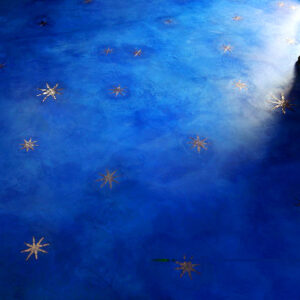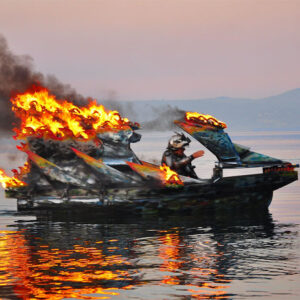On a sunny July afternoon of the early 1970’s Francine de Saint Amand, an attractive Canadian friend and the owner of an art gallery in Montreal, landed in Pantelleria. As soon as she arrived at my house, she dumped her luggage, undressed, and lay down on the domed roof to take a sunbath.
My house is by the sea at the bottom of a steep hill, served by a windy road that descends around the side of this hill.
Less than 10 minutes after Francine’s decision, a group of local youngsters was already perching on the parapet wall of the road, enjoying the unexpected and free spectacle of a naked blonde against the background of the sea.
“Get dressed,” I shouted!

“This body is mine, and I do what I want with it,” she answered, quoting the battle cry of the feminist movement of the time!
“Don’t be silly,” I told her, “if one of those kids gets excited and falls off the wall, he will ask us to pay for his medical expenses.”
This monetary argument convinced her to get dressed but, to my surprise, she enquired about the blond guy at the center of the group.
I smiled, realizing that Francine had not only appreciated the local voyeurism, but also figured out a possible prey.
“His name is Onassis,” I answered.
“Why? Is he also a rich kid?” she asked.
“On the contrary,” I replied, “the rumor is that often, when he was having lunch at Tikirriki, a bar and restaurant fronting the harbor, when he saw the bill coming he’d scarper off with ease, telling the waiter to charge his account. This habit went on for a couple of weeks until one day, the owner of the restaurant confronted him.”
“Who do you think you are,” he screamed, “Onassis?”
“And, from that day on, he was nicknamed Onassis!”
A week later, Francine seduced the blond guy on a passionate moonless night.

I recall this story because this morning, while driving along the road that leads to Tracino, the hilltop village, I saw Onassis on the side of the road, tinkering with his house gate.
Although our respective hair has now turned white (his more that mine!), we still look and feel the same. I stopped, got out the car, and hugged him.
“Do you remember Francine?” I asked.
His face lit up with a big smile, then he asked me to wait and disappeared inside his house. A few minutes later he returned with a case of home-grown tomatoes, onions, garlic and zucchini, his seasonal payback for a memorable night of fifty years ago.
I accepted his payback and continued my ride to Tracino, where I met Gail Blacker, a New York artist seduced by this island some 25 years ago.

Although Gail and I have been friends for only a few years, her first contact with Pantelleria dates back to 1974 when, by chance, she rented my house at Cala Tramontana for a vacation with friends.
A fashion designer in her previous life in New York City, Gail now makes mesmerizing mosaics to embroider her clients’ baths and kitchens, light up with refined clouds the domes of the dammusi, and insert refined flying carpets into the polished cement floors of their residences. Gail’s works are mostly done with mother of pearl, but she also uses clams, shells, glass, steel and dry seeds.
I ask her what made her abandon her successful career in New York City for Pantelleria, and she replies that she found on this island a simpler and more authentic world, and never regretted her move.

Angela Speck, a German artist who designs children’s books and has been a resident of Pantelleria for more than 30 years, confirms this feeling.
“Being aware of your feelings is a precious gift,” remarks Angela, “and living in Pantelleria highlights all of our senses but particularly, our minds and hearts. The bottom line is that Pantelleria is a timeless space, suspended between the sky and the sea.”

Another German artist transplanted on this island 27 years ago is Karin Eggers who designs and builds (with her own hands) sinuous metal awning structures that remind me of Victor Horta’s Art Nouveau projects in Brussels.
Karen’s structures are covered with canvas, palm leaves or straw mats to create shaded areas that blend gracefully with the local architecture and the island’s landscape of stone terraces.
Like sweet flowers attract bees, Pantelleria appeals to creative minds and free spirits, of which Paolo Buggiani is an extraordinary specimen.

Paolo is a painter, sculptor and fire performer who lived in New York City more than 20 years, and was, along with Keith Haring, one of the Street Art’s pioneers.
Paolo uses Pantelleria as the background for his prehistoric animals and his fire performances. His metal reptiles ride the island’s stonewalls and climb the surfaces of dammusi, while his fire shows at Lago di Venere (a lake in the mouth of a volcanic crater) recall the island’s genesis and offer memorable experiences.

“This island is special,” states Paolo, “because, having been for millennia a crossing point in the Mediterranean, it has been molded by a variety of rich and diverse cultures.”
I remind him that fire is not welcome in Pantelleria because, in recent years, it was responsible for the destruction of thousands of green areas on an island with no sweet water.
“Fire is not responsible for those destructions,” he rebuts, “the responsibility falls on a few barbaric arsonists who destroy the earth’s life and energy for generations to come.“
And he adds: “I am not an arsonist, but an artist who knows the power of fire better than anyone else and, because of this knowledge, I use it as a primary ingredient of my work and the main element of a prophetic ritual to the universal powers. Fire is for me like a primary color that integrates my landscape paintings and portraits,” he concludes to clarify the function of fire in his artistic research.

Then he invites me to watch one of his fire performances in the Ghirlanda Valley, the setting of a fabulous agricultural landscape in the island’s interior. This time, his fire climbs the steps of a ladder projected towards the sky to reach the clouds. It is sunset and the burning ladder seems suspended in the air, even if it looks anchored to the ground by its long shadow, accentuated by the evening sun. I am so enchanted by the magic of the event that I feel I could capture the green ray of the sunset.
That night I met with Pinuccia, a retired housewife who, in 1969, was the innocent witness of an event that has rightly become part of the history of Pantelleria.

It was July 20, the day the Apollo spaceship landed on the moon.
Pinuccia was 17 years old, and looked like Maria Grazia Cucinotta in the movie “The Postman”. That year, Pinuccia was working in the house of Enrico Cicogna, the translator of the Italian edition of One Hundred Years of Solitude.
Gabriel Garcia Marques had just arrived on the island and was a guest of Cicogna, in his house at Tre Pietre, a tourist settlement near Scauri.
“That evening,” Pinuccia recalls, “I was working in the kitchen while Cicogna and Garcia Marques were discussing on the terrace deck the news of the Apollo landing.”
“Suddenly,” Pinuccia continues, visibly excited, “Garcia Marques felt that I was watching him secretly from behind and turned around. He looked at me so intensely that I felt he was undressing me with his eyes. Then, he smiled and turning back to Cicogna said, “Pantelleria looks better than the moon.”
I have some doubts about the veracity of Pinuccia’s narcissistic interpretation, and rather think that Gabo’s sentence reflected his belief that the volcanic landscape of Pantelleria was a living example of the magic realism of his Macondo.
Unfortunately, neither Gabo nor Cicogna are around today to tell us how to interpret that sentence but, whatever the interpretation, this statement has enormously increased the pride of the islanders.












